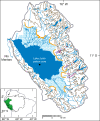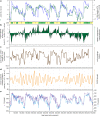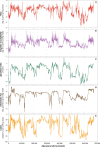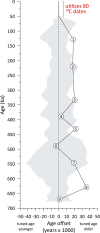700,000 years of tropical Andean glaciation
- PMID: 35831604
- PMCID: PMC9279143
- DOI: 10.1038/s41586-022-04873-0
700,000 years of tropical Andean glaciation
Abstract
Our understanding of the climatic teleconnections that drove ice-age cycles has been limited by a paucity of well-dated tropical records of glaciation that span several glacial-interglacial intervals. Glacial deposits offer discrete snapshots of glacier extent but cannot provide the continuous records required for detailed interhemispheric comparisons. By contrast, lakes located within glaciated catchments can provide continuous archives of upstream glacial activity, but few such records extend beyond the last glacial cycle. Here a piston core from Lake Junín in the uppermost Amazon basin provides the first, to our knowledge, continuous, independently dated archive of tropical glaciation spanning 700,000 years. We find that tropical glaciers tracked changes in global ice volume and followed a clear approximately 100,000-year periodicity. An enhancement in the extent of tropical Andean glaciers relative to global ice volume occurred between 200,000 and 400,000 years ago, during sustained intervals of regionally elevated hydrologic balance that modified the regular approximately 23,000-year pacing of monsoon-driven precipitation. Millennial-scale variations in the extent of tropical Andean glaciers during the last glacial cycle were driven by variations in regional monsoon strength that were linked to temperature perturbations in Greenland ice cores1; these interhemispheric connections may have existed during previous glacial cycles.
© 2022. The Author(s).
Conflict of interest statement
The authors declare no competing interests.
Figures








Comment in
-
Sediment study finds the pulse of tropical glaciers.Nature. 2022 Jul;607(7918):241-243. doi: 10.1038/d41586-022-01841-6. Nature. 2022. PMID: 35831591 No abstract available.
References
-
- Shackleton NJ, Opdyke ND. Oxygen isotope and paleomagnetic stratigraphy of equatorial Pacific core V28-238: oxygen isotope temperatures and ice volumes on a 105 year and 106 year scale. Quat. Res. 1973;3:39–55. doi: 10.1016/0033-5894(73)90052-5. - DOI
-
- Lisiecki LE, Raymo ME. A Pliocene-Pleistocene stack of 57 globally distributed benthic δ18O records. Paleoceanography. 2005;20:PA1003.
-
- Denton, G. H. & Hughes, T. The Last Great Ice Sheets (Wiley, 1981).
-
- Ruddiman, W. F. Earth’s Climate: Past and Future (W.H. Freeman and Company, 2014).
Publication types
LinkOut - more resources
Full Text Sources

